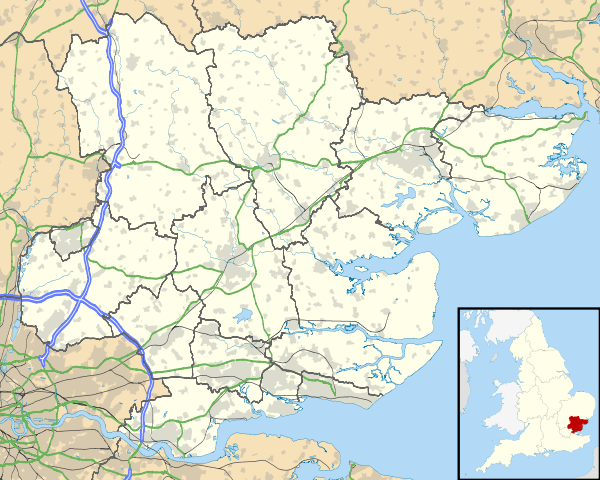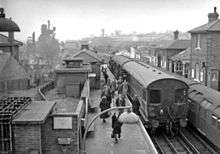Epping tube station
Epping is a London Underground station in the market town of Epping in Essex, England. The station serves as the north-eastern terminus of the Central line. Located in Travelcard Zone 6, it is one of eight London Underground stations in the Epping Forest District.[5] The station before Epping is Theydon Bois, which is about three minutes' travelling time away.
| Epping | |
|---|---|
Station entrance | |
 Epping Location of Epping in Essex | |
| Location | Epping |
| Local authority | District of Epping Forest |
| Grid reference | TL462015 |
| Managed by | London Underground |
| Number of platforms | 2 |
| Accessible | Yes (Platform 1 is step free exit only but Platform 2 is fully accessible.) [1] |
| Fare zone | 6 |
| London Underground annual entry and exit | |
| 2014 | |
| 2015 | |
| 2016 | |
| 2017 | |
| 2018 | |
| Key dates | |
| 1865 | Opened |
| 1949 | London Underground services start |
| 18 April 1966 | Goods yard closed[4] |
| 1994 | Ongar services end |
| Other information | |
| External links | |
| WGS84 | 51.693°N 0.1138°E |
History
In 1856, the Eastern Counties Railway opened a double-track railway between Stratford and Loughton. In 1865, its successor, the Great Eastern Railway, added a single-track extension from Loughton to Ongar. The popularity of the line led to the doubling of the track between Loughton and Epping in 1892.[6] The line was well served, with 50 trains operating between Liverpool Street and Loughton each day, a further 22 continuing to Epping and 14 more to Ongar.
Loughton to Epping became part of the London Underground Central line on 25 September 1949, leaving the single track line from Epping to Ongar as the last steam-worked section. British Railways continued running Ongar services until 1957 when the line was electrified and became part of the Central line.[7] However, services did not run through to the rest of the Central line except for occasional depot workings, so passengers to/from stations beyond Epping normally had to change platforms for the single-track line to Ongar, North Weald or Blake Hall stations.[8] On 2 November 1981, Blake Hall closed and trains passed through the station. On 30 September 1994 London Underground withdrew the service between Epping and Ongar and subsequently sold off that section of the Central line.
On 11 May 2008 an e-petition calling for the reopening of North Weald and Ongar stations was created on the Downing Street website.[9][10] It closed on 11 December 2008 with 1012 signatures. Part of the Epping-Ongar line is now a heritage railway, the Epping Ongar Railway.
Epping Station was to be the terminus of the proposed London Underground Chelsea-Hackney line (Crossrail 2).[11] However, since 2013, the route options for this proposed line have been amended to terminate at New Southgate instead and no longer include the Epping branch.[12]
The station today
Epping station saw a growth in passenger numbers in the mid 1990s due to the closures of nearby North Weald, Blake Hall and Ongar stations. This growth has continued due to significant development in Epping itself and surrounding villages. Another major contributing factor is that many people living in not too distant towns such as Harlow, Bishop's Stortford, and Chelmsford use the station instead of their own National Rail stations, because it is considerably cheaper to travel to London by London Underground than it is to use National Rail services. Growth is now at such a point where the station's car park is full by 6:30 am and parking around the station (as with other stations on this part of the line, e.g. Theydon Bois and Debden) has become a serious problem for local residents, which in turn has caused many residents and local groups to call for the re-opening of North Weald and Ongar stations to help ease demand on Epping station.[13][14]
Trivia
- The longest possible journey on the London Underground without changing trains is the Central line route between West Ruislip and Epping (34.1 miles / 54.9 km).[15]
- Epping station counts approximately 6,200 users daily.[16]
- Epping has the largest public London Underground station car park with 519 spaces.[16]
Gallery
| Wikimedia Commons has media related to Epping tube station. |
- Station platform Roundel
- Platform 1 looking north
- Platform 2 looking north, with a siding branching off to the left in the distance, and the former single-track route to Ongar to the right
- Platform 2 looking south
- Looking south from footbridge
 The station in 1957
The station in 1957
References
- "Step free Tube Guide" (PDF). Transport for London. May 2020. Archived (PDF) from the original on 7 August 2020.
- "Multi-year station entry-and-exit figures (2007-2017)" (XLSX). London Underground station passenger usage data. Transport for London. January 2018. Retrieved 22 July 2018.
- "Station Usage Data" (CSV). Usage Statistics for London Stations, 2018. Transport for London. 21 August 2019. Retrieved 27 April 2020.
- Hardy, Brian, ed. (March 2011). "How it used to be - freight on The Underground 50 years ago". Underground News. London Underground Railway Society (591): 175–183. ISSN 0306-8617.
- "The Tube". Epping Forest District Council. Archived from the original on 26 November 2009. Retrieved 2009-09-30.
- Follenfant 1974, p. 117.
- Green 1987, p. 54.
- Follenfant 1974, p. 120.
- "New fight to reopen Ongar rail line". 9 July 2008. Retrieved 29 September 2008.
- "Local news from Epping - Epping Forest Guardian".
- Feather, Clive. "Technical information about the Chelsea-Hackney Line". Retrieved 7 March 2008.
- Crossrail 2 June 2014 Consultation
- "Epping Tyres Slashed In Parking Row". East London and West Essex Guardian Series. 28 February 2008. Retrieved 30 September 2009.
- "Our Village Was Not Built To Become A Car Park For Those Outside The Area". East London and West Essex Guardian Series. 21 May 2008. Retrieved 30 September 2008.
- "Line facts: Central line". Transport for London. Archived from the original on 14 September 2008. Retrieved 2008-09-30.
- "Epping station to be refurbished and improved". Transport for London. 10 October 2005. Archived from the original on 9 June 2008. Retrieved 2008-09-30.
Bibliography
- Follenfant, H G (1974). Reconstructing London's Underground. London Transport Executive. ISBN 978-0-85329-039-1.CS1 maint: ref=harv (link)
- Green, Oliver (1987). The London Underground An Illustrated History. Ian Allan. ISBN 978-0-7110-1720-7.CS1 maint: ref=harv (link)
External links
- London's Abandoned Tube Stations - Epping to Ongar branch
- Epping station in 1952
- Epping station in 1953
| Preceding station | Following station | |||
|---|---|---|---|---|
| Central line | Terminus | |||
| Historical railways | ||||
| Theydon Bois Line and station open |
Great Eastern Railway Loughton-Ongar |
North Weald Line closed, station open | ||
| Preceding station | Following station | |||
| Terminus | Central line Epping-Ongar branch | towards Ongar |
||
| Terminus | Epping Ongar Railway | North Weald | ||